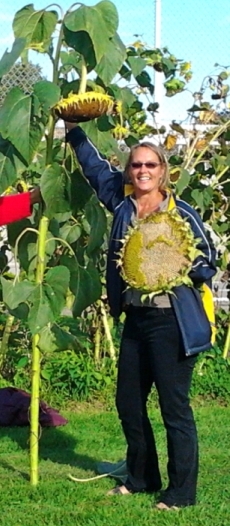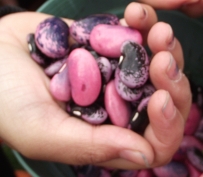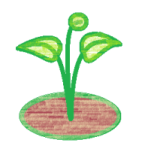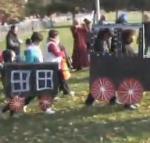
346 Lansdowne Avenue, Toronto
MacGregor Park

The Process of Starting Your Own Teaching or Community Garden In Toronto
The Grassroots Version - Introduction
Addressed to all general community groups
.
This Story is about the path you must walk to get to the point of a prepared garden, ready for your community group to start planting. This Story is not a text book on “how” to start a community garden, there are several of those that have already been created. However, I hope that this story will help you across all the steps.
.
I would like to start with the comparison between a sunflower plant and a full tree of the same diameter of branch. In one season the sunflower can can grow seven to eight feet tall, and have a big flower head, however, it doesn't make it through the winter. A tree, on the other hand, will take several years to reach that size, however, it has strong roots that can weather the seasons and will continue to grow strong and endure.
.

Why do I use this comparison?
I have seen community gardens that have started up quickly – One example was near my area, they had a public meeting, however the folks that came were only the ones interested in having a plot. The “nay-sayers” didn't show up until the the ground was dug up, and the posts were in. After a very stressful second public meeting, they were forced to remove the garden.
Then there is the story of some organization making a film of a one day “quick-build” - community garden – however there was no community group in place to take over, so the few people involved had to struggle to keep the garden going.
My point – Starting a community garden should take a bit of time. There may be one or two people that are inspired to start a community garden, but you need to have at least five or six people as the core of the community group to begin this journey. They need to be ready to stick with it through thick and thin, and able to endure setbacks – because there will be disappointments along the way. This group should have strong roots in the community already. They should be able to draw on this strength and they should be able to hear what the community folks are saying - what type of community garden is the best fit for their area.

.
The Next Steps:

Planting the seeds – the idea of a community garden. Where to plant them? We start at home, with our friends and neighbours, however, we need to branch out – each area of Toronto is so different, some have a strong cultural background – like “China Town” or “Little Italy”, some are very mixed cultures, but, being able to reach out to these groups will strengthen your roots.

.
Seedlings Part one:
- Where will you start this garden?
- Which park?
- What part of the park will you want to have this garden?
- How big do you think this garden will be?
- How many people will be involved with the garden?
- How will the plots be divided up?
Seedlings Part two:
More questions than you want to face - what to do? If it is in a city park, you need to get the okay from the city. If it is in the back yard of a church, or the property of an apartment building or the grass area of a business, or an empty lot, you need to find the owners and get their permission ... but you are not ready to start the garden yet.
.

Once you have found at least one location ... you may have ideas of how you would like it to look, but don't engrave these ideas in stone – The real seedlings are what you find in your first public meeting.
I cant say this enough, advertise your meeting!. Make sure everyone around the park that you would like to place your garden in, is contacted. Leave fliers in their mail boxes, post the message in the local grocery store, convenience store, and the library. Whatever it takes to get the word out.
Up until now, you have been speaking with like minded people about the garden and have had very good feed back. However, now comes one of the first challenges, the nay-sayers! (page 3) As annoying as it may seem, they are a very important part of the process, and you must hear what they have to say. Just like little seedlings need to be harden off, so does your community group. It doesn't mean you have to stop your plan of a garden, but it will force you to focus on why you want to have a garden here, and what the benefits will be. You will need to take notes and work on what these challenges are and, if necessary, modify part of the garden plan. However, keep in mind the benefits of a community garden in the neighbourhood. If your garden is well kept, and presented right, it will bring new life to the park and help strengthen the community and neighbourhood.
Fertilizing – Strengthening your sapling - the next few steps are easy to say – not so easy to do. You will have more meetings, modifying your garden plans, and at the same time you need to build your community group. The Community Garden Handbook, and the Community Garden Tool Kit talk about having committees, the steering committee, communications committee, the fund raising committee ... etc. “In My Opinion” I would like to say that the “committee” word scares away many people. However, extending the opportunity of a leadership role – is what we want to see. I have found that creating teams, and having team captains works out well. It is also an opportunity for all the - will be - gardeners to get involved right away while you are waiting for the garden approval. This will strengthen the group and you will be able to establish your own style of the community process. You also are required to have a list of Garden rules or Garden Guidelines. That is where the TCGN website come is handy, there is a list of resources in the tab called “In The Shed” and that is where you will find sample garden guidelines and other documents for a starting community garden. You can use these documents as templates for creating your own documents that fit the need of your community group.
... There is much to do, however, I hope that this information will give you the tools to start your garden growing! ...
- Down Load this as a pdf: The Process of Starting Your Own Community Garden In Toronto
.




 Show search options
Show search options




 You are on the [ProcessOfStartingA-CG-Aug2014] page of folder [Gardens]
You are on the [ProcessOfStartingA-CG-Aug2014] page of folder [Gardens] For the cover page of this folder go to the
For the cover page of this folder go to the